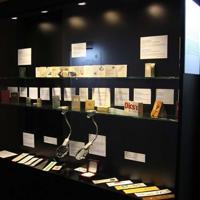The Paper and Book Art Museum displays unique artifacts

IZMIR
The Paper and Book Art Museum of Ege University in the Aegean province of Izmir, the first of its kind in Turkey, houses the world’s smallest book, the lightest paper and many other valuable national and international items on its shelves.
Class=”cf”>
“In our museum, we exhibit the smallest book in the world, which measures 2.4 by 2.9 millimeters. It is so small that you can only look at it with a magnifying glass,” said Seda Ağırbaş, a faculty member at the university and director of the museum.
The Paper and Book Art Museum presents the long history of paper and books, indispensable components of the last 2000 years of world cultural history and examples from different cultures, and hosts many scientific and cultural events throughout the year.
“The establishment of the Ege University Paper and Book Arts Museum, which opened in 2012, is of great importance as it is the first of its kind in Turkey and a university museum. The museum is located in the 19th century Ballian Residence, one of the Levantine mansions, one of the cultural and artistic assets of Ege University. Nearly 1,000 objects are exhibited in the museum, which also includes an art gallery. Examples from different stages, from papermaking to the point where it becomes a work of art, are exhibited in the museum,” she said.
“On the ground floor there is a demo room for handmade paper production, organic writing materials, colored paper from all over the world, departments for colored paper of today and modern paper art. On the upper floor there are departments for book art, bookplates, printing, artist books, children’s books, book formats, master books, printing techniques, miniature books and typography. In our museum we exhibit the smallest book in the world, whose dimensions are 2.4 by 2.9 millimeters. It is so small that you can only look at it with a magnifying glass. The Paper and Book Art Museum is a knowledge museum, a contemporary art museum and a universal museum,” she added.
Class=”cf”>
Works exhibited in a historical setting
Ağırbaş said the best thing about the museum is that it is located in a historical building and the works are exhibited in a historical atmosphere.
Class=”cf”>
“The exhibition space is very important for visitors. Display cases and lighting in the exhibition of works, the presentation of works and objects in display cases, on walls and in open spaces requires care and effort. It is extremely important to light the works and position them in such a way that the viewer can look at them without eye fatigue,” she added.
Ağırbaş explained that museums have an educational function: “While the common purpose of almost all museums is collecting, preserving, documenting and exhibiting, the educational function has also been added to the duties of museums by UNESCO. Museums are known as extracurricular learning places due to their educational function. People learn by experiencing, observing and even listening in museums.”
“We explain to visitors information such as the printing press and organic writing materials. We offer them the opportunity to see book forms from different civilizations. Almost 1,000 objects and works of art are displayed both on the walls and in the showcases of all the rooms of our museum. We also have a memoir collection where our visitors share their thoughts. It has become a special publication. One visitor wrote: ‘They put the world under our feet, we didn’t know it’ and that made us very happy,” she added.



